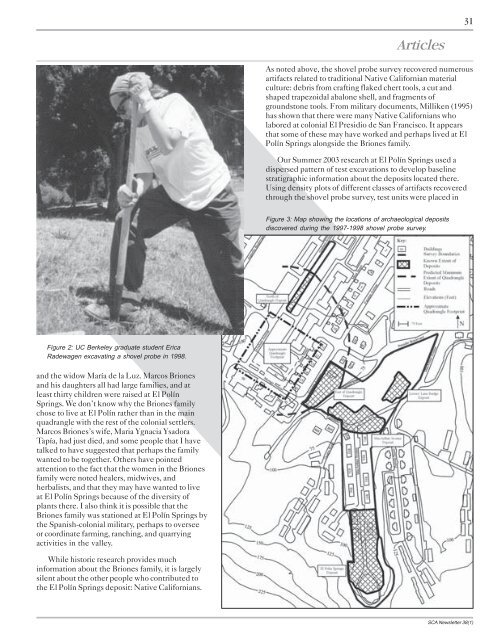March 2004 - Society for California Archaeology
March 2004 - Society for California Archaeology
March 2004 - Society for California Archaeology
You also want an ePaper? Increase the reach of your titles
YUMPU automatically turns print PDFs into web optimized ePapers that Google loves.
31<br />
Articles<br />
As noted above, the shovel probe survey recovered numerous<br />
artifacts related to traditional Native Cali<strong>for</strong>nian material<br />
culture: debris from crafting flaked chert tools, a cut and<br />
shaped trapezoidal abalone shell, and fragments of<br />
groundstone tools. From military documents, Milliken (1995)<br />
has shown that there were many Native Cali<strong>for</strong>nians who<br />
labored at colonial El Presidio de San Francisco. It appears<br />
that some of these may have worked and perhaps lived at El<br />
Polín Springs alongside the Briones family.<br />
Our Summer 2003 research at El Polín Springs used a<br />
dispersed pattern of test excavations to develop baseline<br />
stratigraphic in<strong>for</strong>mation about the deposits located there.<br />
Using density plots of different classes of artifacts recovered<br />
through the shovel probe survey, test units were placed in<br />
Figure 3: Map showing the locations of archaeological deposits<br />
discovered during the 1997-1998 shovel probe survey.<br />
Figure 2: UC Berkeley graduate student Erica<br />
Radewagen excavating a shovel probe in 1998.<br />
and the widow María de la Luz. Marcos Briones<br />
and his daughters all had large families, and at<br />
least thirty children were raised at El Polín<br />
Springs. We don’t know why the Briones family<br />
chose to live at El Polín rather than in the main<br />
quadrangle with the rest of the colonial settlers.<br />
Marcos Briones’s wife, Maria Ygnacia Ysadora<br />
Tapía, had just died, and some people that I have<br />
talked to have suggested that perhaps the family<br />
wanted to be together. Others have pointed<br />
attention to the fact that the women in the Briones<br />
family were noted healers, midwives, and<br />
herbalists, and that they may have wanted to live<br />
at El Polín Springs because of the diversity of<br />
plants there. I also think it is possible that the<br />
Briones family was stationed at El Polín Springs by<br />
the Spanish-colonial military, perhaps to oversee<br />
or coordinate farming, ranching, and quarrying<br />
activities in the valley.<br />
While historic research provides much<br />
in<strong>for</strong>mation about the Briones family, it is largely<br />
silent about the other people who contributed to<br />
the El Polín Springs deposit: Native Cali<strong>for</strong>nians.<br />
SCA Newsletter 38(1)

















